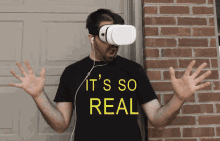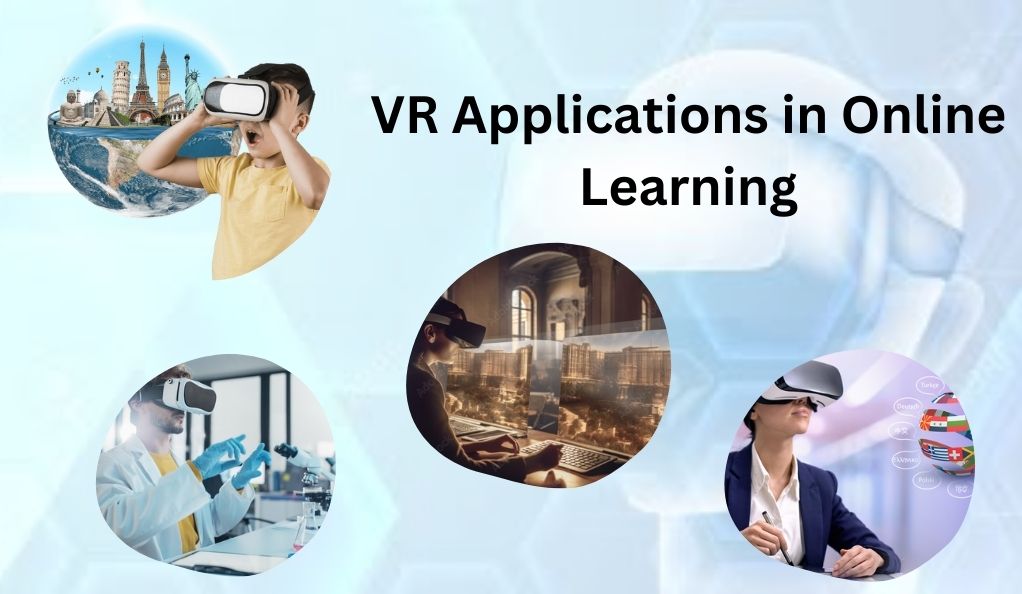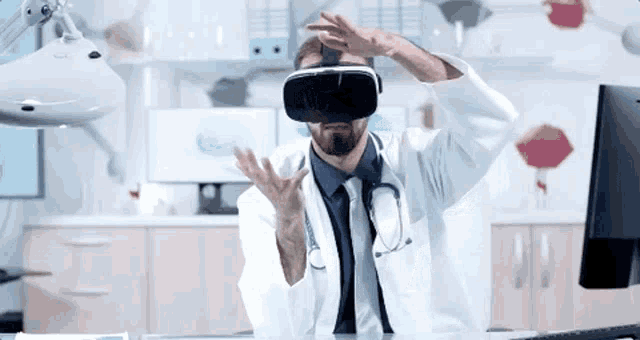How Virtual Reality is Changing the Game in Online Education
Welcome to the exciting world of online education, a realm where technology meets learning, creating a dynamic and immersive experience. In recent times, we’ve witnessed a significant shift in how we learn and teach, thanks to the advent of Virtual Reality (VR). VR is not just a buzzword; it’s a revolutionary tool that’s reshaping the landscape of online education.
Imagine stepping into a classroom that’s not limited by walls, where you can travel to ancient cities, dissect a virtual frog, or even walk on the moon, all from the comfort of your home. This is the power of VR in online learning – it brings lessons to life, making them interactive, engaging, and more effective than ever before.

In this, we’ll delve into how VR is revolutionizing online education. We’ll explore its unique capabilities that make learning not just an activity, but an adventure. Whether you’re a student, educator, or just curious about the future of learning, you’re about to discover how VR is opening doors to new educational possibilities. Let’s embark on this journey to understand how virtual reality is changing the game in online education.
How to Understand Virtual Reality in the Context of Online Education
Virtual Reality, or VR, is like stepping into a computer-created world that feels almost real. It’s a technology that lets you explore and interact with a 3D environment using special equipment like VR headsets and sometimes gloves or other gear. When you put on a VR headset, you might feel like you’re in a different place, like a far-off planet, a historical event, or a science lab.
VR in education means using this technology to learn new things in a way that’s more like experiencing them than just reading about them. Let’s break down the main parts of VR:
- VR Headset: This is like a big pair of goggles that covers your eyes and shows you the virtual world.
- Controllers: These are held in your hands to interact with the VR environment, like picking up objects or drawing.
- Sensors: These track your movement, so when you move in the real world, your character in the virtual world moves too.
The Evolution of VR Technology in Educational Settings
VR has come a long way, especially in how it’s used for learning. Here’s a brief look at its journey:
- Early Stages: VR started as a complex and expensive technology, used mostly for research or in high-end gaming.
- Growing Accessibility: Over time, VR became more user-friendly and affordable, allowing schools and learning centers to start using it.
- Current Trends: Now, VR in education is not just a cool idea but a real tool. It’s used for virtual field trips, interactive lessons, and even for practicing skills like surgery or public speaking.
How Virtual Reality Enhances Online Learning Experiences
Virtual Reality takes online learning to a whole new level. Imagine putting on a headset and suddenly, you’re not just looking at a screen anymore. You’re in a world where you can walk around, touch things, and feel like you’re really there. This is what we call an immersive learning environment. It’s like being inside the lesson instead of just watching it.
In a VR classroom, you can:
- Interact: Pick up virtual objects, experiment with them, and see how they work.
- Engage: Feel more connected to what you’re learning because it’s like you’re part of the story.
- Focus: With no outside distractions, it’s easier to concentrate and understand the material.
Examples of VR Applications in Online Learning

VR is used in many exciting ways in online education. Here are a few examples:
- Virtual Field Trips: You can visit the pyramids of Egypt, explore the ocean floor, or even travel to Mars, all from your classroom.
- Science Labs: Conduct experiments in a virtual lab where you can mix chemicals or dissect a frog without any mess or danger.
- Historical Events: Walk through historical events, like standing on the streets during the signing of the Declaration of Independence.
- Language Learning: Practice speaking a new language in a virtual setting that mimics being in a country where that language is spoken.
VR in online learning is not just about watching videos; it’s about stepping into a whole new world of experiences that make learning come alive. These examples show just how much VR can enhance the way we learn, making it more interactive and exciting.
How to Overcome Challenges in Online Learning with VR
One of the big challenges in online learning is feeling alone. When you’re just looking at a screen, it’s easy to feel disconnected from your teacher and classmates. But VR changes this. It creates a virtual space where you can be ‘with’ others, even when you’re physically far apart.
In a VR classroom, you can:
- Meet and Talk: See and interact with teachers and classmates as if you were in the same room.
- Work Together: Join others in group projects or experiments, making learning a shared experience.
- Feel Part of a Community: Instead of feeling alone, you’re part of a lively, interactive learning environment.
Bridging the Gap Between Theory and Practical Application
Often, what we learn in theory doesn’t make sense until we see it in action. That’s where VR comes in handy. It bridges the gap between just reading about something and actually experiencing it.
With VR, you can:
- Apply What You Learn: For example, in a virtual car mechanic class, you can ‘fix’ a car engine and see how different parts work together.
- Understand Complex Concepts: VR can simplify difficult ideas by showing them in a 3D space.
- Practice Safely: Get hands-on experience in fields like medicine or engineering without the risks associated with real-life practice.
By overcoming challenges like isolation and the gap between theory and practice, VR is not just improving online learning; it’s revolutionizing it. These changes make learning more interactive, social, and effective, helping students grasp and retain knowledge better than ever before.
How to Implement VR in Online Learning Curriculums
Adding Virtual Reality to online courses isn’t as hard as it sounds. It’s about blending VR experiences with the lessons you already have. This way, students get the best of both worlds: the flexibility of online learning and the immersive experience of VR.
To integrate VR, you can:
- Start Small: Add VR as a supplement to existing courses. For example, a virtual lab for a science course.
- Use Available Resources: Many VR educational tools are ready to use, so you don’t have to create everything from scratch.
- Train Teachers: Help teachers understand how to use VR in their lessons, making the transition smoother.
The Benefits of Using Virtual Reality in Online Education
One of the biggest wins of using Virtual Reality in online education is how it hooks students’ attention. Instead of passively watching a video or listening to a lecture, VR makes students active participants in their learning. They get to dive into a virtual world, making the learning experience exciting and memorable.
Here’s how VR boosts engagement:
- Interactive Lessons: Students can touch, move, and interact with virtual objects, keeping them involved and interested.
- Fun Learning: VR turns lessons into enjoyable experiences. It’s like being in a game, which can be a big motivator for students.
- Real-World Feel: VR can simulate real-life situations, making learning more relevant and engaging.
Enhanced Retention and Understanding of Complex Subjects
Remembering what you learn is crucial, and VR is great at making lessons stick. By creating realistic 3D models and simulations, VR helps students understand complex subjects easily and remember them longer.
Benefits of VR for complex subjects:
- Visual Learning: Seeing things in 3D makes it easier to grasp complex ideas, like the structure of DNA or the solar system.
- Hands-On Experience: VR gives students a chance to ‘do’ things, which reinforces learning through experience.
- Reduced Distractions: The immersive nature of VR keeps students focused, which helps in better understanding and retaining information.
The use of VR in online education not only makes learning more engaging and enjoyable but also enhances the understanding and retention of complex subjects. By providing an immersive and interactive learning environment, VR makes education more effective and memorable.
How to Navigate the Challenges and Limitations of VR in Education

Technical and Accessibility Issues
Virtual Reality brings a futuristic edge to learning, but it’s not without its bumps in the road. The biggest challenges are often technical and about making sure everyone can use VR. Not all students have the latest tech at home, and VR gear can be pricey and a bit complex to set up. These hurdles can make it hard for everyone to jump into VR learning.
To smooth out these bumps, schools are coming up with creative solutions. They’re offering easy-to-follow guides to help both teachers and students get the hang of VR technology. They’re also exploring more budget-friendly VR options that work with smartphones, making virtual learning more accessible. Plus, for those who can’t get their hands on VR gear, schools are developing non-VR ways to learn the same material, ensuring no one misses out.
Balancing VR with Traditional Learning Methods
Introducing VR into education doesn’t mean saying goodbye to traditional learning. In fact, it’s about finding the perfect mix. VR is a powerful tool, but it’s just one part of a bigger educational picture. Reading, writing, and good old-fashioned classroom discussions are still key to learning. The goal is to use VR to make these traditional methods even more engaging, not to replace them.
Schools are embracing this balance by using VR to bring lessons to life and then tying these experiences back to traditional learning activities. For example, a virtual trip to ancient Egypt in a history class is followed by a writing assignment or group discussion. This approach not only keeps learning varied and interesting but also respects different learning styles. Regular feedback from students and teachers helps fine-tune this balance, ensuring VR enhances the educational experience in just the right way.
Conclusion
Virtual Reality (VR) is revolutionizing the realm of online education, transforming it into a vivid, interactive journey. It goes beyond traditional methods, engaging students in a way that textbooks and lectures simply can’t match. By creating immersive experiences, VR enhances understanding and retention, particularly in complex subjects. While challenges like accessibility and technical issues exist, the key lies in balancing VR with conventional learning techniques, ensuring a comprehensive educational experience. As we continue to explore and integrate VR, it holds the promise of making learning not just more effective but also more inclusive and exciting. Embracing VR in education is not just about keeping up with technology, but about unlocking new and imaginative ways of understanding and interacting with the world of knowledge.


Leave a Reply